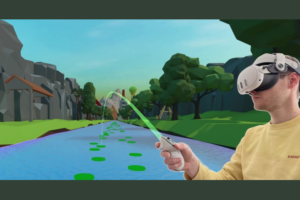
Source: Put Me There Project
Virtual reality (VR) has developed into a promising technology that opens up new ways for people to interact with digital content. By putting on VR glasses, users are immersed in a virtual 3D environment that they can explore through natural body movements and direct interaction with their hands. In addition to games, VR is already being used successfully in a variety of ways, for example to train new skills, support medical procedures, preserve cultural heritage and evaluate architectural designs, to name just a few of the different areas of application.
However, most virtual environments in the various application areas are larger than the physical area in which a user can move around with VR glasses. Therefore, navigation techniques that move the user’s position through the environment purely virtually are crucial to enable unrestricted exploration.
Teleportation Avoids Sensory Discrepancies
While the simplest way to navigate virtually is to continuously move the user’s position, research has shown that continuous movement is particularly likely to cause feelings of cybersickness. This feeling is similar to the motion sickness experienced on a ship and includes symptoms such as nausea, dizziness, headaches and eye strain. A likely explanation for this effect is a sensory mismatch between what the eyes see and what the vestibular system feels. A commonly used alternative to continuous movement is therefore teleportation, where the user simply indicates their desired destination with a pointing beam and is then immediately taken there. With this approach, there is no sensory mismatch and several studies have confirmed that teleportation minimizes the risk of developing cybersickness. This key benefit to user comfort has made teleportation the de facto standard for navigation in many commercial and academic applications.
The DFG Project ‘Put me There’
Despite the importance of teleportation for VR applications across all disciplines, however, some important research questions about the fundamental building blocks that make up these technologies are still unanswered. In order to clarify these, RWTH Aachen University has been involved in a DFG-funded research project with the University of Trier since June 2024, which aims to deepen the understanding and expressiveness of teleportation techniques in VR. In a series of user studies, various teleportation parameterizations and technical enhancements are being analyzed that enable users to gain new perspectives on the scene, reach destinations more quickly and maneuver around objects of interest more efficiently. Based on the already widespread use of teleportation in head-mounted displays, these fundamental research findings will have a profound impact on a variety of academic and industrial virtual reality applications.
Project Partners
The project is being carried out by the two project leaders Dr Tim Weissker at the IT Center of RWTH Aachen University and Dr Daniel Zielasko at the Chair of Human-Computer Interaction at Trier University. The doctoral students and student assistants involved at RWTH Aachen University are Daniel Rupp (M.Sc.) and Matthis Franzgrote (B.Sc.).
Responsible for the content of this article is Tim Weissker.




